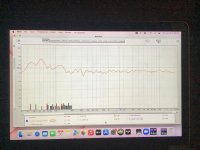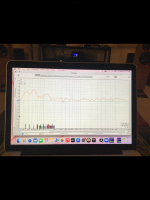baffle step compensation
galu just responded to a question from another member.you are still trying to point out all my stupidities
baffle step compensation
galu just responded to a question from another member.
pardon but Galu offers me zero in my ‘ quest ‘. Lol
thanks for the acronym definition!
yes, but this is an open forum. any member can contribute. that's the great thing about it.pardon but Galu offers me zero in my ‘ quest ‘
Baffle Step Compensation (BSC) is very important for speakers set at the front of a stage, or outdoors. Bass leaks out the back and is not heard by the audience. For speakers indoors backed against a wall, I find BSC to be unnecessary. A 1" plaster wall right behind the speaker boosts my SP2(2004) from 12 db down at 20 hz factory spec to -3 db.
Your frequency measurements post 28 are interesting, but I can't tell from labels which ones are 16 uf and which 18. That rise at 60 hz could be annoying on classical sources, thrilling on R&R. That dip at 2.4 khz ? could also be annoying. I'd try to compensate for either with further crossover tweaking; I bought +-3db speakers for $200 each (used) and want them that way. A lot of people recommend DSP now instead of passive crossover but running 4 or 6 amps (one for each driver) wastes electricity if you can do the job with capacitors & inductors.
I second the motion that manufacturer knew what capacitor they were buying even if the marking is nearly out of tolerance. No pro manufacturer runs without a serious incoming inspection department. Wrong marking gets the manufacturer cheaper parts, or confuses the customer when he DARES to buy any part not from an authorized repair shop.
Your frequency measurements post 28 are interesting, but I can't tell from labels which ones are 16 uf and which 18. That rise at 60 hz could be annoying on classical sources, thrilling on R&R. That dip at 2.4 khz ? could also be annoying. I'd try to compensate for either with further crossover tweaking; I bought +-3db speakers for $200 each (used) and want them that way. A lot of people recommend DSP now instead of passive crossover but running 4 or 6 amps (one for each driver) wastes electricity if you can do the job with capacitors & inductors.
I second the motion that manufacturer knew what capacitor they were buying even if the marking is nearly out of tolerance. No pro manufacturer runs without a serious incoming inspection department. Wrong marking gets the manufacturer cheaper parts, or confuses the customer when he DARES to buy any part not from an authorized repair shop.
The first attachment is the 16uf and the second is 18uf.
but they weren’t taken in the same exact mic placement
do not a good indicator
and yes I can’t get rid of that 60hz peak to save my life. It’s my room. And yes I have treatment etc.
but they weren’t taken in the same exact mic placement
do not a good indicator
and yes I can’t get rid of that 60hz peak to save my life. It’s my room. And yes I have treatment etc.
Attachments
To eliminate room effects in speaker measurement, you can 1. measure outdoors. 2 m from speaker a cardioid mike can work. I do this; cardioid mikes are also useful for recording me at my instrument. I use a camera tripod as a mike mount and a stool to get speaker up off ground.
2 Use a dedicated omni mike a half meter or less from the speaker and use gating software like REW (room effect wizard) to chop the measurement off before the room reflections come back.
And definitely for making comparisons, make all measurements at the same distance and position.
2 Use a dedicated omni mike a half meter or less from the speaker and use gating software like REW (room effect wizard) to chop the measurement off before the room reflections come back.
And definitely for making comparisons, make all measurements at the same distance and position.
This is one reason why the industry irks me.I second the motion that manufacturer knew what capacitor they were buying even if the marking is nearly out of tolerance. No pro manufacturer runs without a serious incoming inspection department. Wrong marking gets the manufacturer cheaper parts, or confuses the customer when he DARES to buy any part not from an authorized repair shop.
Manufacturers build to a price, with sound quality taking a back seat.
Electrolytic Capacitors are known to deteriorate in value.
Time, heat, as well as electrode & electrolyte composition are variables involved.
When I see the quality of crossover components selected by renowned Loudspeaker manufacturers I shake my head.
The crossover pic of these Proacs include iron core Inductors, Sandcast resistors & Electrolytic Caps.
In vintage speakers, manufacturers designs were restricted by what was available at the time.
Surely, marketed correctly companies such as Proac can do better.
I'd be asking whether the uf value is the only factor that affects sound reproduction when using electrolytic capacitors?
Last edited:
This is one reason why the industry irks me.
Manufacturers build to a price, with sound quality taking a back seat.
Electrolytic Capacitors are known to deteriorate in value.
Time, heat, as well as electrode & electrolyte composition are variables involved.
When I see the quality of crossover components selected by renowned Loudspeaker manufacturers I shake my head.
The crossover pic of these Proacs include iron core Inductors, Sandcast resistors & Electrolytic Caps.
In vintage speakers, manufacturers designs were restricted by what was available at the time.
Surely, marketed correctly companies such as Proac could do better.
I'd be asking whether the uf value is the only factor that affects sound reproduction when using electrolytic capacitors?
i agree with you man
at $4k for the speakers they should have done at least a touch better.
cheers
In my opinion, if you can land a well engineered design, buy the best quality parts for your budget and build DIY.
Also MSRP has no bearing on how good Loudspeakers are, in my opinion.
Without knowledge and experience in this area, not to mention appropriate measuring equipment, changing the crossover parts could result in degrading the sound performance.
Even recapping from electrolytic to poly caps with same value can end up being neutral, better or worse.
Also MSRP has no bearing on how good Loudspeakers are, in my opinion.
Without knowledge and experience in this area, not to mention appropriate measuring equipment, changing the crossover parts could result in degrading the sound performance.
Even recapping from electrolytic to poly caps with same value can end up being neutral, better or worse.
Last edited:
For 4k, you probably got $300 or $400 worth of parts/construction and $3,600 worth of name.i agree with you man
at $4k for the speakers they should have done at least a touch better.
cheers
That Alcap would be about $3 & the iron core Inductors about $6 - $10.
Imaging the Loudspeakers you could own if you spent 4k on parts and a superlative design!
Last edited:
Do you suspect someone swapped out the cap?If the loudspeakers is a first hand that came from the factory 3 years ago then the lythics are still ok.
But I saw a mismatch betweenbthe two speakers...around 0.47 uf. It may be wanted or not.
In tones post there's an Alcap on the crossover board along with 3 4 Proac Caps, but in tombo's post there are 4 Proac Caps which appear film.
Fwiw, you would also have to consider cost of r&d, which, of course depends very much on the number of sold pairs/units.$3,600 worth of name.
No I more surmise one channel need 0.47 uF difference or 0.47 precision is enough for Proac in that design at this highish cut-off (understand affect no that much the result)Do you suspect someone swapped out the cap?
In tones post there's an Alcap on the crossover board along with 3 4 Proac Caps, but in tombo's post there are 4 Proac Caps which appear film.
There may be multiple causes. Some within crossover control, but likely more involved than you'd expect. This particular MTM implementation has idiosyncrasies which cannot be seen in the limited measurements taken so far.i was thinking of maybe ‘ filling in that BBC dip ‘ by making some changes to the xo values
BSC - baffle step compensation. The low pass series inductor is increased in value to linearize and compensate for the low end midrange loss when using a smaller speaker baffle. Thats why small speakers have low efficiency, often in the low 80s dB/w.
Edit- just realized my browser didn't refresh... oops
Edit- just realized my browser didn't refresh... oops
Do you suspect someone swapped out the cap?
In tones post there's an Alcap on the crossover board along with 3 4 Proac Caps, but in tombo's post there are 4 Proac Caps which appear film.
nah , Proac uses those caps extensively.
For 4k, you probably got $300 or $400 worth of parts/construction and $3,600 worth of name.
That Alcap would be about $3 & the iron core Inductors about $6 - $10.
Imaging the Loudspeakers you could own if you spent 4k on parts and a superlative design!
well , I agree up to a point, but Proac did have a pretty recognizable designer Stewart Tyler. It’s not like he was chopped liver.
i picked these speakers out after hearing a ton of speakers. And I didn’t even know at that point who Proac was, so I had zero bias.
they make a really good loudspeaker.
but yeah, they totally rip us off on parts many many times.
i don’t know about diy though. Although it seems way better on paper, I haven’t heard any which make news. Could be a number of reasons. But most of the time when I think of DIY i see people building speakers from drivers made by Dayton audio for the most part. that accounts for 90% of what I see.
except for people like Troels and a couple others who use high end drivers.
There may be multiple causes. Some within crossover control, but likely more involved than you'd expect. This particular MTM implementation has idiosyncrasies which cannot be seen in the limited measurements taken so far.
yes very true, MTM is notorious for its poor vertical axis measurement.
but I will still experiment and see what happens. It’s fun and I might get lucky and/or learn a thing or two.
thanks Allen
- Home
- Loudspeakers
- Multi-Way
- Why would a manufacturer use a 16uf cap that is really 18uf?

